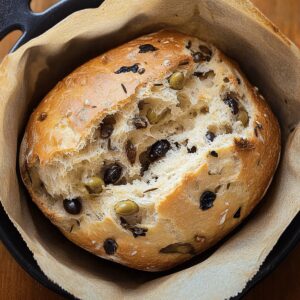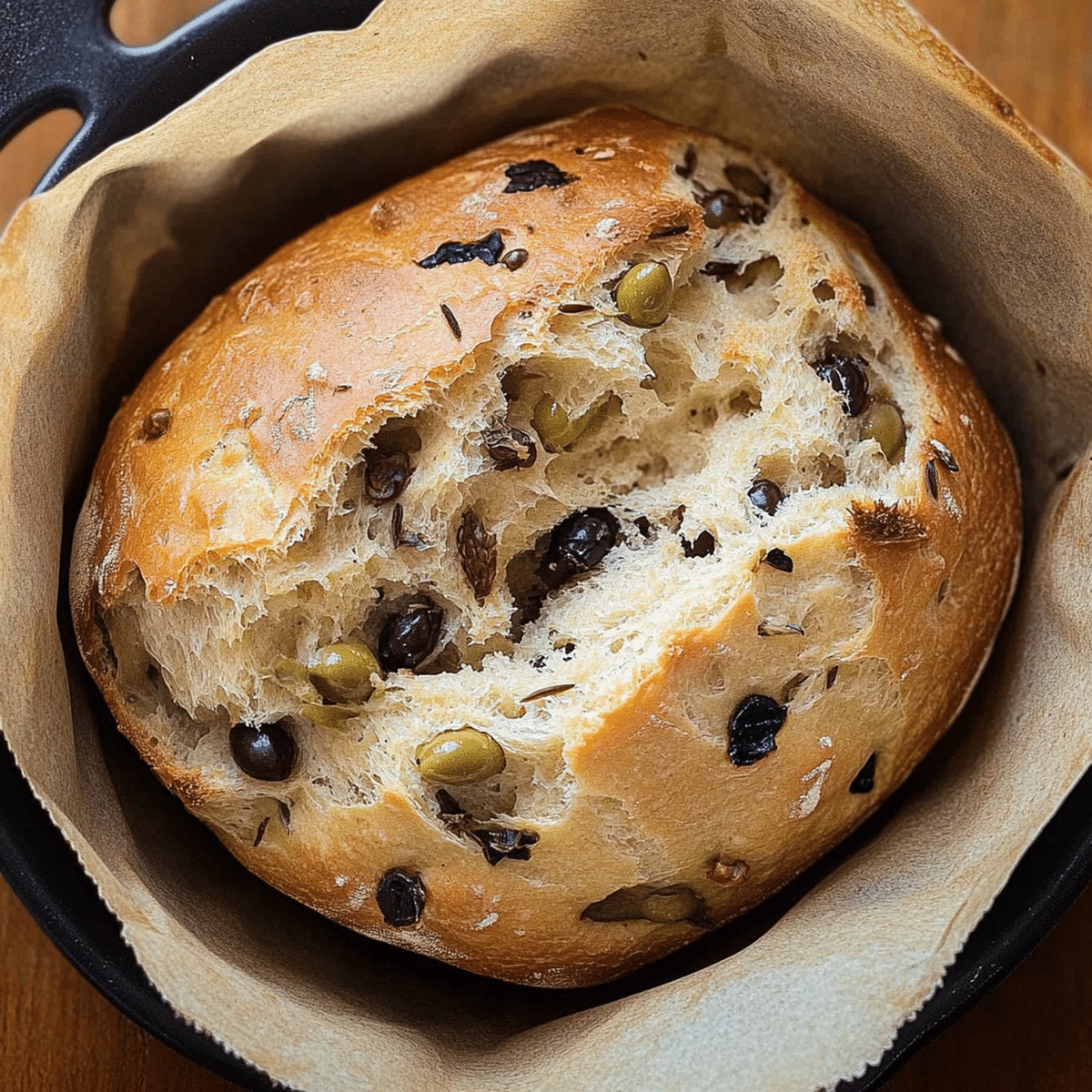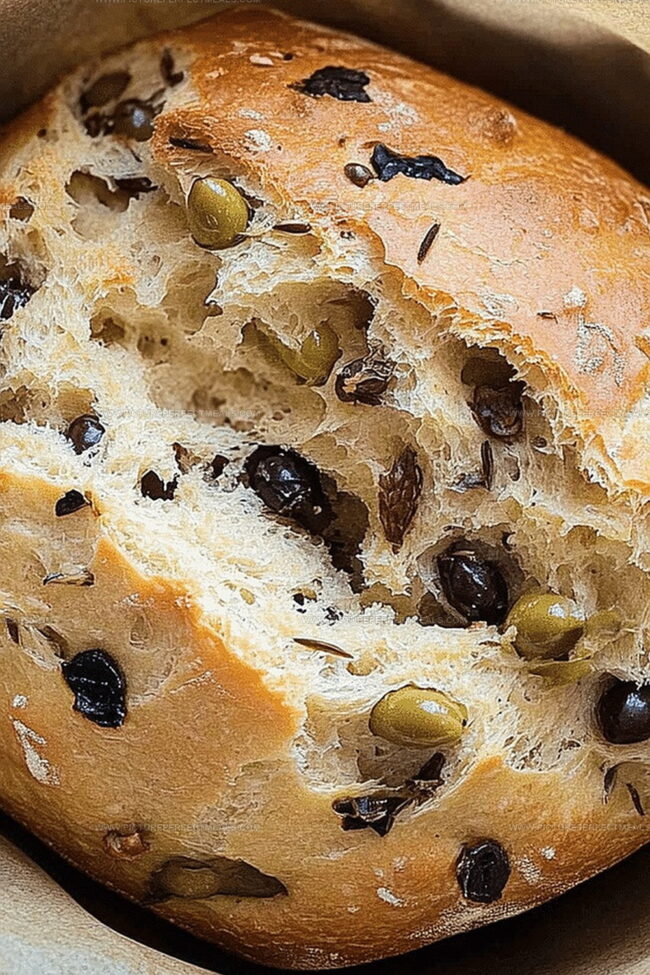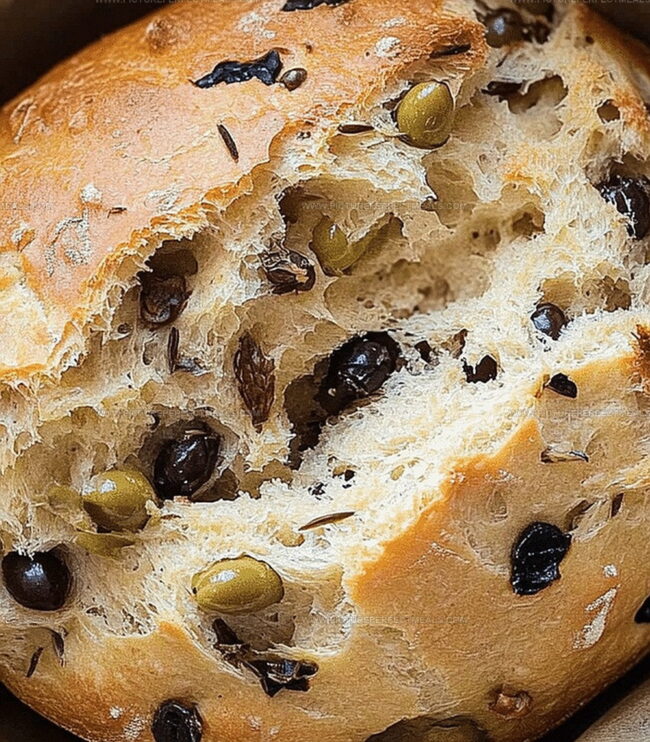Rustic Homemade Olive Bread Recipe – Flavor-Packed Delight
Mediterranean kitchens have long treasured this olive bread with its rustic charm and deep, earthy flavors.
Crusty exterior and soft interior promise a delightful sensory experience that transports you straight to sunny hillsides.
Fragrant herbs and briny olives weave magic into each slice, creating something far beyond ordinary bread.
Kneading the dough becomes a meditative ritual, connecting you to generations of bakers who perfected this craft.
Salt-studded and golden, the bread emerges from the oven with an irresistible aroma that fills your kitchen.
Warm slices beg to be torn and shared, inviting conversation and connection around your table.
You’ll want to slice into this bread while it’s still steaming, letting its complex flavors tell a delicious story.
Why Olive Bread Brings Bold Flavor to the Table
Key Ingredients for Savory Olive Bread
Bread Base:Yeast and Fermentation:Flavor Enhancers:Baking Instructions for Homemade Olive Bread
Step 1: Awaken The Yeast
Grab a small bowl and pour in warm water. Sprinkle sugar and yeast, then let the mixture bubble and transform for 5-10 minutes until it looks frothy and alive.
Step 2: Create Dough Foundation
Grab a spacious mixing bowl and combine flour and salt. Pour in the awakened yeast mixture and olive oil. Stir and mix until a sticky, promising dough emerges.
Step 3: Enrich With Mediterranean Flavors
Ingredients for folding:Knead the dough on a flour-dusted surface for 8-10 minutes until smooth and stretchy. Pro tip: Use a stand mixer with a dough hook for 5-6 minutes if you prefer.
Step 4: First Rise Adventure
Transfer dough to a greased bowl. Drape a clean kitchen towel over the top and park it in a cozy, warm corner. Allow the dough to expand and double in size within 1-2 hours.
Step 5: Shape The Bread
Gently deflate the risen dough. Mold it into a round or oval loaf. Place on parchment-lined baking sheet or inside a greased loaf pan.
Step 6: Second Rise Preparation
Cover the shaped dough with a towel. Let it rise again for 30-45 minutes. Meanwhile, heat the oven to 400F.
Step 7: Bake To Golden Perfection
Slide the bread into the preheated oven. Bake for 30-35 minutes until the crust turns golden brown. Test doneness by tapping the bottom- it should sound hollow.
Step 8: Cool And Savor
Transfer bread to a wire rack. Allow it to cool completely. Slice and enjoy warm or at room temperature with butter or olive oil.
Olive Bread Tips for Great Texture and Taste
How to Store and Reheat Your Olive Bread
Dishes That Work with Olive Bread
Unique Variations of Olive Bread to Try
Print
Olive Bread Recipe
- Total Time: 55 minutes
- Yield: 12 1x
Description
Mediterranean olive bread weaves rich, tangy flavors into a rustic loaf that whispers of sun-drenched coastal kitchens. Crusty exterior and tender crumb invite you to savor each aromatic slice with pure Mediterranean charm.
Ingredients
Main Ingredients:
- 3.5 cups (440 g) all-purpose flour
- 1 cup (150 g) pitted olives, chopped (black, green, or a mix)
- 1.5 cups (360 ml) warm water (110°F/43°C)
Seasoning and Flavor Enhancers:
- 2 teaspoons salt
- 1 teaspoon dried rosemary (or 1 tablespoon fresh, chopped)
- 1 teaspoon dried oregano
- 1 teaspoon sugar
Leavening and Binding Agents:
- 1 packet (2.25 teaspoons) active dry yeast
- 2 tablespoons olive oil
Instructions
- Activate the yeast by whisking it with tepid liquid and a pinch of sweetener, allowing the mixture to bloom and become foamy for approximately 8 minutes.
- Create a flour foundation in a spacious mixing vessel, integrating salt and creating a central well for the activated yeast and fragrant olive oil.
- Gently incorporate chopped Mediterranean olives, aromatic rosemary, and earthy oregano into the developing dough, ensuring even distribution of these flavor-enhancing ingredients.
- Transform the dough on a lightly dusted work surface, kneading with rhythmic motions until achieving a smooth, supple texture that springs back when gently pressed.
- Transfer the dough to a lightly oiled ceramic bowl, draping a clean cloth over the top and positioning in a draft-free, warm environment to encourage expansive rising for approximately 90 minutes.
- Deflate the risen dough with a careful punch, then mold into a rustic round or elegant oval shape, positioning on a parchment-lined baking surface.
- Allow a secondary rising period, covering the shaped loaf to protect it from drafts, which will further develop its complex texture and flavor profile.
- Heat the oven to a precise 400 degrees Fahrenheit, creating an ideal baking environment for transforming the raw dough into a golden, crusty masterpiece.
- Bake until the exterior achieves a rich, burnished golden hue and produces a hollow resonance when tapped, signaling perfect internal development.
- Rest the freshly baked bread on a wire cooling rack, permitting it to stabilize and develop its final texture before slicing and serving.
Notes
- Ensure water temperature is precisely lukewarm around 110°F to activate yeast without killing it, preventing dense bread texture.
- Experiment with different olive varieties like Kalamata or green olives for unique flavor profiles and visual interest.
- For gluten-sensitive individuals, substitute wheat flour with gluten-free blend plus xanthan gum to maintain bread’s structural integrity.
- Enhance bread’s nutritional value by incorporating whole wheat flour or adding seeds like sunflower or pumpkin for extra crunch and nutrients.
- Prep Time: 20 minutes
- Cook Time: 35 minutes
- Category: Snacks, Appetizer, Breakfast
- Method: Baking
- Cuisine: Mediterranean
Nutrition
- Serving Size: 12
- Calories: 150
- Sugar: 0.5 g
- Sodium: 300 mg
- Fat: 3 g
- Saturated Fat: 0.5 g
- Unsaturated Fat: 2.5 g
- Trans Fat: 0 g
- Carbohydrates: 28 g
- Fiber: 1 g
- Protein: 4 g
- Cholesterol: 0 mg




Daves Miller
Contributing Chef & Culinary Educator
Expertise
Education
Sullivan University, Louisville, Kentucky
White Mountains Community College, Berlin, New Hampshire
Daves is the friendly face guiding you through flavorful, fuss-free recipes at Picture Perfect Meals.
He studied culinary arts at Sullivan University and embraced Baking and Pastry Arts at White Mountains Community College. Daves specializes in comforting meals with vibrant flavors, highlighting fresh, seasonal ingredients.